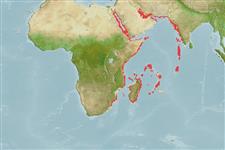>
Syngnathiformes (Pipefishes and seahorses) >
Syngnathidae (Pipefishes and seahorses) > Nerophinae
Etymology: Dunckerocampus: From Duncker, an ichthyologist and taxonomist that recognized four Gobiidae families (1928) + Gr, kampe = bent.
Eponymy: Dr Paul Georg Egmont Duncker (1870–1953) was a German zoologist and ichthyologist. [...] (Ref. 128868), visit book page.
More on author: Regan.
Environment: milieu / climate zone / intervalo de profundidade / distribution range
Ecologia
marinhas associadas(os) a recifes; intervalo de profundidade 3 - 45 m (Ref. 9407). Tropical
Western Indian Ocean: Red Sea and Sodwana Bay, South Africa to the Chagos Islands and Maldives.
Tamanho / Peso / Idade
Maturidade: Lm ? range ? - ? cm
Max length : 19.0 cm TL macho/indeterminado; (Ref. 48635)
Descrição breve
Chaves de identificação | Morfologia | Morfometria
Espinhos dorsais (total) : 0; Raios dorsais moles (total) : 20 - 23; Espinhos anais: 0; Raios anais moles: 4. Usually with 4-5 dark bands crossing opercle (Ref. 4281).
Body shape (shape guide): eel-like.
Common among coral and in reef caves and crevices; usually found in pairs. Nearly always seen swimming upside down against ceiling of caves (Ref. 48635). Ovoviviparous (Ref. 205). The male carries the eggs in a brood pouch which is found under the tail (Ref. 205).
Life cycle and mating behavior
Maturidade | Reprodução | Desova | Ovos | Fecundidade | Larvas
Male carries the eggs in a brood pouch (Ref. 205).
Dawson, C.E., 1985. Indo-Pacific pipefishes (Red Sea to the Americas). The Gulf Coast Research Laboratory Ocean Springs, Mississippi, USA. (Ref. 5316)
Categoria na Lista Vermelha da IUCN (Ref. 130435: Version 2024-2)
Ameaça para o homem
Harmless
Utilização humana
Ferramentas
Relatórios especiais
Descarregue XML
Fontes da internet
Estimates based on models
Preferred temperature (Ref.
123201): 24.7 - 29.4, mean 27.3 °C (based on 140 cells).
Phylogenetic diversity index (Ref.
82804): PD
50 = 0.5078 [Uniqueness, from 0.5 = low to 2.0 = high].
Bayesian length-weight: a=0.00093 (0.00036 - 0.00242), b=3.05 (2.83 - 3.27), in cm total length, based on LWR estimates for this (Sub)family-body shape (Ref.
93245).
Nível Trófico (Ref.
69278): 3.8 ±0.55 se; based on food items.
Resiliência (Ref.
120179): Elevada, tempo mínimo de duplicação da população menor que 15 meses (Preliminary K or Fecundity.).
Fishing Vulnerability (Ref.
59153): Low vulnerability (10 of 100).
🛈
Nutrients (Ref.
124155): Calcium = 94.8 [54.9, 191.0] mg/100g; Iron = 0.777 [0.447, 1.446] mg/100g; Protein = 18.2 [17.0, 19.3] %; Omega3 = 0.125 [0.072, 0.224] g/100g; Selenium = 35.8 [18.4, 78.9] μg/100g; VitaminA = 78.5 [26.8, 221.0] μg/100g; Zinc = 1.4 [0.9, 2.0] mg/100g (wet weight);
